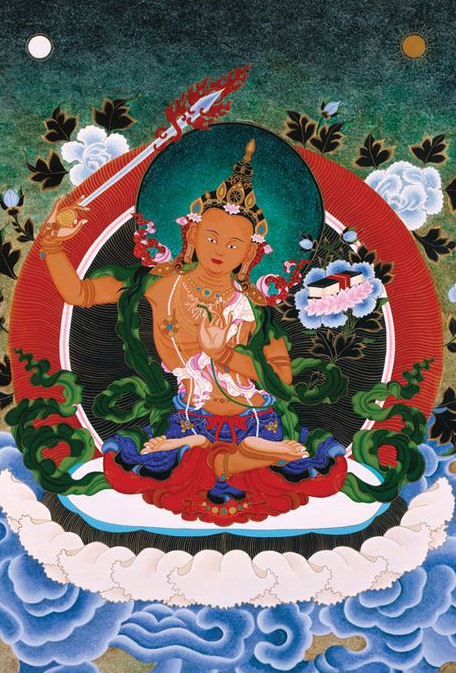Manjushri

- See also :
- See also :
Mañjushri (Skt. Mañjuśrī; Tib. འཇམ་དཔལ་དབྱངས་, Jampalyang; Wyl. 'jam dpal dbyang) or Mañjughosha (Skt. Mañjughoṣa; Tib. འཇམ་དབྱངས་, Jamyang; Wyl. ‘jam dbyangs; 'the Gentle Voiced') is
- one of the eight great bodhisattvas who were the closest disciples of the Buddha. In this form, he sometimes appears whitish-green in colour and holding a lily to symbolize renunciation of the destructive emotions.
- the embodiment of the knowledge and wisdom of all the buddhas, traditionally depicted with a sword in his right and a text in his left hand.
Jamyang Khyentse Wangpo says:
- In definitive terms, Mañjushri, you are now, and from the very beginning you have always been, a genuine buddha, in whom all the qualities of abandonment and realization are totally perfected, because you completely traversed all ten bhumis, such as the Joyous and so on, and purified the two obscurations, together with any latent habitual tendencies, many incalculable aeons ago. Nevertheless, from a merely provisional perspective, you appear as the foremost of all the bodhisattvas, and demonstrate the means of training as a bodhisattva in the presence of all the victorious ones and their heirs throughout the ten directions.
- Moreover, from the perspective of the mantrayana, there is no doubt whatsoever that you, Mañjushri, are a buddha. In fact, this is even stated in the sutras. In the Sutra of the Array of Mañjushri’s Pure Land, for example, it says you have completed the ten bhumis. And in two other sutras—the Shurangama-samadhi Sutra and the Angulimala Sutra—you are clearly referred to as a buddha. [1]
Footnotes
Further Reading
- Jamgön Mipham, A Garland of Jewels, (trans. by Lama Yeshe Gyamtso), Woodstock: KTD Publications, 2008
See Also
External Links
- Manjushri series on Lotsawa House
- A Few Remarks—An Explanation of the Praise to Noble Mañjushri known as Glorious Wisdom’s Excellent Qualities
- Manjushri outline page at Himalayan Art Resources
Source
Mañjuśrī. (T. ’Jam dpal; C. Wenshushili; J. Monjushiri; K. Munsusari 文殊師利). In Sanskrit, “Gentle Glory,” also known as Mañjughoṣa, “Gentle Voice”; one of the two most important Bodhisattvas in Mahāyāna Buddhism (along with Avalokiteśvara). Mañjuśrī seems to derive from a celestial musician (Gandharva) named Pañcaśikha (Five Peaks), who dwelled on a five-peaked mountain (see Wutaishan), whence his toponym. Mañjuśrī is the bodhisattva of wisdom and sometimes is said to be the embodiment of all the wisdom of all the buddhas. Mañjuśrī, Avalokiteśvara, and Vajrapāṇi are together known as the “protectors of the three families” (Trikulanātha), representing wisdom, compassion, and power, respectively. Among his many epithets, the most common is Kumārabhūta, “Ever Youthful.” Among Mañjuśrī’s many forms, the most famous shows him seated in the lotus posture (Padmāsana), dressed in the raiments of a prince, his right hand holding a flaming sword above his head, his left hand holding the stem of a lotus that blossoms over his left shoulder, a volume of the Prajñāpāramitā atop the lotus. Mañjuśrī plays a major role in many of the most renowned Mahāyāna sūtras. Mañjuśrī first comes to prominence in the Vimalakīrtinirdeśa, which probably dates no later than the first century CE, where only Mañjuśrī has the courage to visit and debate with the wise layman Vimalakīrti and eventually becomes the interlocutor for Vimalakīrti’s exposition of the dharma. In the Saddharmapuṇḍarīkasūtra, only Mañjuśrī understands that the Buddha is about to preach the “Lotus Sūtra.” In the Avataṃsakasūtra, it is Mañjuśrī who sends Sudhana out on his pilgrimage. In the Ajātaśatrukaukṛtyavinodana, it is revealed that Mañjuśrī inspired Śākyamuni to set out on the bodhisattva path many eons ago, and that he had played this same role for all the buddhas of the past; indeed, the text tells us that Mañjuśrī, in his guise as an ever-youthful prince, is the father of all the buddhas. He is equally important in tantric texts, including those in which his name figures in the title, such as the Mañjuśrīmūlakalpa and the Mañjuśrīnāmasaṃgīti. The bull-headed deity Yamāntaka is said to be the wrathful form of Mañjuśrī. Buddhabhadra’s early fifth-century translation of the Avataṃsakasūtra is the first text that seemed to connect Mañjuśrī with Wutaishan (Five-Terrace Mountain) in China’s Shaanxi province. Wutaishan became an important place of pilgrimage in East Asia beginning at least by the Northern Wei dynasty (424–532), and eventually drew monks in search of a vision of Mañjuśrī from across the Asian continent, including Korea, Japan, India, and Tibet. The Svayambhūpurāṇa of Nepal recounts that Mañjuśrī came from China to worship the Stūpa located in the middle of a great lake. So that humans would be able worship the stūpa, he took his sword and cut a great gorge at the southern edge of the lake, draining the water and creating the Kathmandu Valley. As the bodhisattva of wisdom, Mañjuśrī is propiated by those who wish to increase their knowledge and learning. It is considered efficacious to recite his mantra “oṃ arapacana dhīḥ” (see Arapacana); Arapacana is an alternate name for Mañjuśrī.
Source
The Princeton Dictionary of Buddhism by Robert E. Buswell Jr. and Donald S. Lopez Jr.